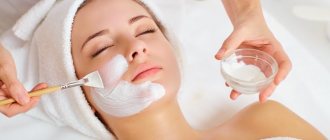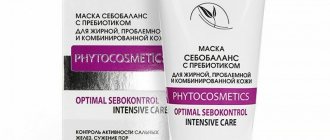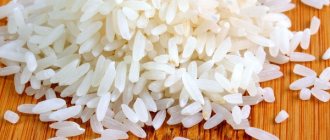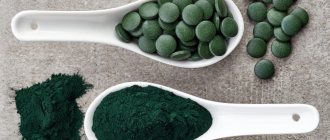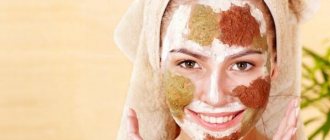Clay as part of face masks is extremely popular in modern cosmetology. This is not surprising, because there are considerable advantages to such facial skin care. For example, a cleansing mask with white clay is a source of many components necessary for the dermis.
What you will learn:
- Cleansing your face with clay
- Cleansing masks based on different types of clay Scrub mask made of black clay and fresh lemon juice
- Blue clay to restore complexion
- White clay to combat age spots
- Green Clay Cleanser
- Gray clay - moisturizing component
- Toning mask with yellow clay
- Skin-soothing red clay mixture
- Table “Effectiveness of masks for certain skin types”
What are the benefits of a clay face mask?
The answer to the question of how a clay mask is useful for a young or aging face lies in the amazing properties of the natural material. Clays of different colors are slightly different. The following shades of the substance are used in cosmetology:
Black. Dries oily skin and nourishes dry skin. Also great for combination skin types. Tightens pores and cleanses them of impurities. Considered a skin super cleanser. Includes:
- iron;
- magnesium;
- calcium;
- strontium;
- quartz.
Yellow. Cosmetologists recommend this type for owners of oily and combination dermis. A good remedy for eliminating the first signs of sagging, tightens the contour, evens out the tone. It is distinguished by the following properties:
- activates metabolic processes in the epidermis;
- tones, refreshes and enriches with oxygen;
- removes toxins, preventing the formation of acne.
Pink is the result of mixing white and red. Applicable for all skin types. It has the following effect on the skin:
- makes it velvety;
- gives elasticity, firmness;
- nourishes, softens;
- rejuvenates, eliminating the first wrinkles;
- makes the contours more defined.
Red. Clay face masks containing this type of natural material are especially suitable for those with hypersensitive dermis prone to irritation and allergic reactions. The properties are:
- activation of intercellular metabolism;
- saturation of the skin with oxygen, vitamins, mineral salts;
- acceleration of blood circulation;
- improvement of lymphatic drainage;
- softening, toning;
- restoration of water balance;
- elimination of irritation, peeling, redness and itching.
Green. An excellent remedy for dry and tight skin. Answering the question about the benefits of masks made from natural green material, cosmetologists note the following effects on the skin:
- restoration of a healthy complexion;
- softening, smoothing;
- removal of shallow wrinkles;
- return of firmness and elasticity properties;
- restoration of hydrobalance.
Blue. Rich in mineral salts and microelements. The dermis has the following effects:
- normalization of cellular metabolism;
- regulation of lymphatic drainage;
- stimulation of blood circulation at all levels of the dermis;
- elimination of pigmentation and freckles;
- rejuvenation due to toning and smoothing the relief;
- elimination of fat content;
- narrowing of pores;
- acne removal;
- acne removal.
White. In pharmacies and cosmetics stores it can be seen under the name kaolin. It has a whole range of useful properties:
- Tightens and tones facial muscles;
- refreshes the color of the skin;
- removes freckles;
- relieves inflammatory processes;
- tightens pores;
- dries.
Knowing the beneficial properties of different colored materials will help you choose the most appropriate type for creating homemade masks.
Chemical composition of clay
Blue clay contains a whole complex of active microelements that the human body needs for the smooth functioning of all vital systems. It is thanks to the presence of a huge amount of useful substances that reliable care for the skin of the face and the whole body is ensured.
Chemical composition:
| Microelement | Importance in cosmetology |
| Silicon | · restores metabolic processes in the tissues of the epidermis; saturates cells with oxygen; · activates collagen synthesis. |
| Iron | · has a powerful rejuvenating effect; · rids cells of harmful toxins and impurities; · improves blood supply processes. |
| Zinc | · characterized by antiseptic, anti-inflammatory, regenerating effects; · relieves redness of the affected areas of the epithelium; · fights inflammatory elements. |
| Copper | · improves the basic protective functions of the skin; · participates in the production of elastin and collagen; · strengthens the weak walls of blood vessels, thereby relieving the skin of telangiectasia. |
| Potassium | · relieves swelling; · has a moisturizing effect and also heals minor wounds and abrasions. |
| Selenium | · promotes more effective absorption of active components by the skin; · prevents the development of cancer cells and various neoplasms. |
| Magnesium | · forms the basis of ATP molecules, which saturate cells with the necessary energy; · smoothes out deep expression wrinkles by increasing the density of dermal fibers. |
| Manganese | Helps cells absorb various active components; · normalizes water balance at the cellular level. |
| Titanium dioxide | · natural broad-spectrum antioxidant; · blocks the negative effects of UV radiation; whitens pigment spots and post-acne; · reduces the amount of secretion produced by the sebaceous glands. |
| Aluminium oxide | · removes the stratum corneum of the epidermis due to its effective exfoliating effect; · evens out skin texture and improves overall complexion. |
Does clay have contraindications and side effects?
A pure clay mask has no contraindications, since its ingredient is 100% natural material that does not cause allergies or irritation. Contraindications may be associated with the use of auxiliary agents that enhance the effect of the main component. For example, honey, often used in home cosmetics, can cause allergies.
There were also no side effects observed when using clay. Other ingredients included in the masks can provoke their appearance.
To be one hundred percent sure that the consistency you created for the face will not cause harm, test the composition before application by applying it to the wrist area for 15-20 minutes. If no signs of irritation appear within the specified period, then the skin has given the green light to use the product.
How clay masks work
Clay minerals have a complex and layered structure. All their properties are based on the ability to accept, retain and release metal ions. The ion exchange process is regulated directly by the cells of our skin, the missing components enter the superficial and deep integuments, and harmful metals go into the clay.
It is important to know that clay only works actively when diluted. The resulting paste allows soluble substances to penetrate deep into the epidermis and interact with both dead and living cells. Clay also contains non-water-soluble particles, such as iron oxides. They are most often responsible only for the color of the clay and are not capable of deep penetration into the skin.
If after a clay mask the skin is very colored, then the clay is not natural, a dye has been added.
When clay gets on the skin, it changes its composition and loses free ions of micro- and macroelements, so necessary for the human body. The structure-forming components are preserved in their original form. This means that all the questionable components of the clay, for example, aluminum ions, do not penetrate inside.
It is worth considering that only real clay from pure natural sources will benefit the skin. Therefore, it is important to choose a natural product.
How often to do and how long to keep a clay mask on your face
A clay face mask will give maximum effect if you follow the rules for applying it. Adhere to the following rules:
- apply the product to previously cleansed and dried skin;
- the layer of home remedy applied to the skin should be quite dense;
- the cosmetic product is not intended to treat the area around the eyes;
- the frequency of procedures depends on the type of dermis, if it is oily, the frequency should be a week, if dry - 10-12 days;
- only clean, cool water is suitable for diluting the main component;
- there should be no lumps in the resulting mixture;
- Complete removal of the dried composition after the end of the procedure is preceded by splashing the remaining product, which can be washed off after soaking.
The answer to the question of how long you can keep a clay mask on your face depends on the type of dermis. If it is oily, the product can be left on the face for about 20 minutes. If dry – no more than 5. For those with normal and sensitive skin, 10 minutes will be enough.
Having answered the questions of how often manipulation can be carried out and how long the drug can be kept on the face, let’s move on to solving the problem of how to make a mask suitable for a particular type of face.
Results
- Homemade masks based on blue and blue clay have a whole list of beneficial properties. They eliminate skin rashes, cleanse pores of impurities, even out complexion and smooth out facial wrinkles.
- The healing effect of the rock is due to the rich content of macro and microelements beneficial for the skin. In addition to nutritional and antiseptic substances, clay also contains antioxidants that prevent premature photoaging of the dermis.
- Before applying the prepared mixture to your face, do not forget to check the quality of the purchased powder. Good blue clay does not stain the skin, and when interacting with water it does not turn into lumps.
- For the best effect, enrich the mixture with additional components of natural origin. For dry skin types, choose base oils with an intense nourishing effect, and for combination and oily skin, products based on clay, active acids and essential oils with an antiseptic effect will be indispensable.
Recipes for the best clay masks
It's time to move on to practice answering the question of how to make the optimal composition for a certain skin type. A clay mask for dry skin differs in content from the preferred set of components for oily dermis.
If your skin is oily
The following recipe will help get rid of oily shine, cleanse pores and prevent acne:
- Take 1 tablespoon of the main component and mix with water (a small amount). You can use mineral or spring water.
- Add 1 teaspoon of cranberry juice to the resulting mixture.
- Keep the product for 15-20 minutes.
- Rinse off first with heated and then cool water.
This clay mask for oily skin can be done 1-2 times a week.
If your skin is dry
Representatives of the fair half of humanity who are faced with the problem of dry dermis will benefit from another recipe for preparing a face mask from clay:
- Take 2 tablespoons of the main component of the preferred color.
- Add 0.5 teaspoon of olive oil. Instead of olive, you can use jojoba or flax oils.
- Pour 1 yolk into the mixture.
- Add a couple drops of essential oil to taste.
- If the consistency is too thick, you should dilute the product with clean water.
- The product is applied to the surface of the face in a thick layer and left until completely dry, and then washed off.
After the procedure, it is advisable to moisturize the skin with a nourishing cream.
If the problem is acne
Clay masks using rock salt are excellent fighters against all kinds of rashes. The following recipe is popular:
- A small amount of salt crystals dissolves in clean water.
- The solution kept for several minutes is filtered.
- Clay is added in small portions. So that the end result is a creamy mass.
- Apply to the face.
If you feel tightness after the procedure, apply a moisturizer. The result will be better if you treat the skin with acidic products.
If, after the rash disappears, spots remain, another composition will get rid of them, in which a pinch of cinnamon is added instead of salt.
Excellent care product
Just because your skin doesn't give you problems doesn't mean it doesn't need care. Happy owners of problem-free skin will benefit from a blue clay face mask; it is very easy to prepare at home:
Add to a small amount of blue clay (1-2 tablespoons) your choice:
- honey;
- cucumber juice;
- sour cream;
- milk;
- pure water.
Whatever ingredient you choose, 1 teaspoon will be enough.
To fight wrinkles
An excellent anti-aging product is the following composition:
- red clay diluted with water;
- 10-15 drops of lemon juice;
- egg yolk;
- a small amount (by eye) of olive oil.
Everything is mixed and applied to the dermis.
Unnecessary pigmentation
Knowing how to properly make a clay face mask, you can easily cope with freckles and age spots. The top formulations include the following recipe:
- Take 1 teaspoon of dry bodyaga.
- Mix with 2 teaspoons of black or white main component.
- Dilute the resulting mixture with clean water.
In reviews, women call this remedy miraculous, as it not only gets rid of pigmentation, but also nourishes and heals.
It is important to remember that compositions with the described product should not be applied to the area around the eyes, eyebrows and mouth. Any variations with this component when drying will injure the delicate skin of vulnerable areas.
How to use a mask correctly
The product will bring maximum benefit provided that the following recommendations are followed:
- You should first prepare the skin before the procedure. Cleanse your face with toner, micellar water or lotion.
- You can steam the dermis using a compress to better open the pores, which promotes deeper penetration of beneficial substances.
- It is necessary to apply the product in a thin layer, evenly, avoiding the area around the eyes and lips.
- It is advisable to distribute the clay mixture over the surface without pressing, using light movements.
- After the procedure, if necessary, you can apply a moisturizing or nourishing cream.
- Use the mask in courses.
The opinion of cosmetologists about clay masks
Cosmetologists around the world unanimously recommend formulations with various types of clays for home use, since this natural material has been tested for thousands of years of use as a rejuvenating and healing agent. The only contraindication to its use may be individual sensitivity, which is extremely rare. Here are some professional tips for those who intend to make a clay face mask at home:
- The effect will be greater if the face is first cleaned and steamed using warm compresses soaked in herbal decoctions.
- Under no circumstances should metal vessels be used to formulate compositions for masks; they are good for preparing the drug:
- ceramics;
- glass;
- porcelain;
- tree.
- It is not recommended to talk after applying a clay face mask; facial movements can cause skin microtraumas.
- If you feel discomfort, the product should be removed from your face before the end of the prescribed period. You cannot tear off the composition in pieces; you can remove it only after preliminary moistening.
Attention! If the mask dries out quickly, it should be moisturized. Do not allow the composition to dry completely on the skin. This may cause irritation.
How to choose clay according to skin type
Natural cosmetic clay of any color with proper and regular care will bring good results. But the maximum effect can be achieved by using the product in accordance with your skin type.
For oily types, white clay is the best choice. Kaolin will remove oily shine and tighten pores. Blue, black and red clays can also compete with white in solving the problems of oily and combination skin . They will dry out acne, eliminate fine wrinkles and unevenness, and reduce tone. With constant use, the skin will become velvety, fat metabolism in the tissues will improve.
Dry skin will respond favorably to clay of any color; the main thing is to add fatty nutritional components to the mask, such as natural vegetable oils or serums. And be sure to ensure that the clay on your face does not dry out.
For sensitive skin, pink clay is best. This combination of substances will gently soothe the skin and saturate it with the necessary components.
Happy owners of normal skin type can safely take any clay. But for the first acquaintance, green is better; it will give great benefits: it will rejuvenate and increase tone.
Review of reviews on clay masks
Of particular interest are reviews from women who regularly pamper their skin by applying clay masks. We did an analysis of forums dedicated to cosmetic clay. After scrolling through more than 30 sites, we came to the following conclusions:
- For 100% of the fair sex who responded, clay of various colors is an absolute cosmetic favorite, which cleanses and dries their skin and helps fight age-related problems;
- the main question that most women ask is how long do you need to leave a clay mask on your face;
- 99% of ladies and girls recommend the product described to their friends as being able to effectively cleanse the skin and, in combination with other ingredients, generously supply it with the necessary complex of useful substances.
To summarize, we invite you to read another useful and interesting report on a given topic:
Peculiarities
Clay can improve the condition of the skin, making it more well-groomed and giving a healthy glow. It can remove toxins from the dermis, remove oily shine and relieve inflammation.
The main advantages of the product are deep and thorough cleansing of the surface, regulation of sebum production, and evenness of facial tone. In addition, the substance makes the skin elastic, elastic and taut. Another useful property of a clay mask is considered to have an antibacterial effect, which is very important in the fight against acne.
Cosmetic clay comes in several types:
- red – tightens, improves blood circulation, saturates tissue with oxygen;
- black is a storehouse of minerals and trace elements, stimulates lymphatic drainage, cleanses the skin, moisturizes and eliminates acne;
- white – suitable for oily dermis, removes oily shine, removes comedones and tightens pores;
- green – effectively tones, eliminates swelling, deeply nourishes, prevents dryness of the epidermis;
- blue – has an antiseptic and anti-inflammatory effect, soothes, relieves redness;
- yellow - suitable for all types of dermis, removes toxins, improves the water balance of the skin, lightens age spots on the face.
High-quality, good clay masks also contain extracts of natural oils, medicinal plants, berries and fruits.
Contraindications for use
Clay masks are suitable for almost everyone, but, like any other skin care product, it has a number of limitations for use:
- Individual intolerance to components
- Allergic reactions
- Chronic skin diseases
- Open wounds on the skin, purulent rashes.
- Skin with rosacea
Natural clay can cause allergies in very rare cases. The only question is to find an environmentally friendly and safe product. An adequate price/quality ratio and real reviews from other customers will help here. It is better to purchase clay in natural cosmetics stores.
